Ben Turner
Thu, February 8, 2024
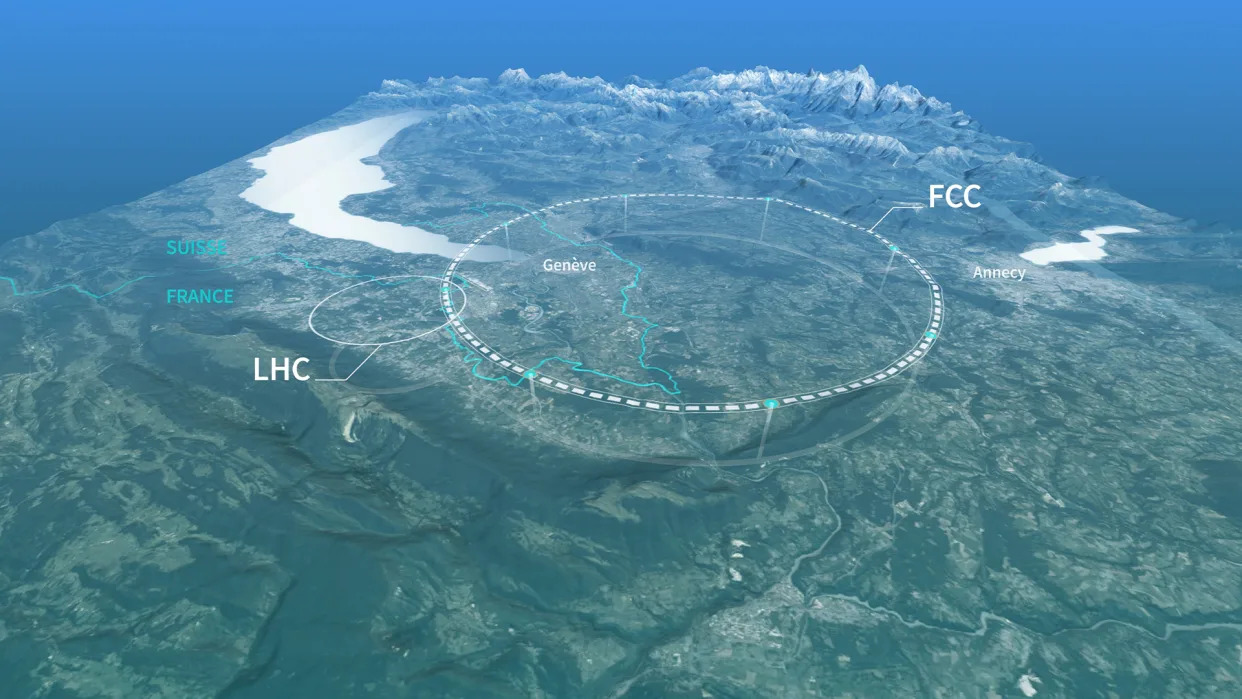
A schematic map showing a possible location for the Future Circular Collider.
Researchers at the world's biggest particle accelerator have put forward proposals to build a new, even larger atom smasher.
The $17 billion Future Circular Collider (FCC) would be 57 miles (91 kilometers) long, dwarfing its predecessor, the 16.5-mile-long (27 kilometers) Large Hadron Collider (LHC), located at the European Organization for Nuclear Research (CERN) near Geneva.
Physicists want to use the FCC's increased size and power to probe fringes of the Standard Model of particle physics, the current best theory that describes how the smallest components of the universe behave. By smashing particles at even higher energies (100 tera electron volts, compared with the LHC's 14), the researchers hope to find unknown particles and forces; discover why matter outweighs antimatter; and probe the nature of dark matter and dark energy, two invisible entities believed to make up 95 percent of the universe.
Related: Our universe is merging with 'baby universes,' causing it to expand, new theoretical study suggests
"The FCC will not only be a wonderful instrument to improve our understanding of the fundamental laws of physics and nature," Fabiola Gianotti, CERN's director-general, said at a news conference Monday (Feb. 5). "It will also be a driver of innovation, because we will need new advanced technologies, from cryogenics to superconducting magnets, vacuum technologies, detectors, instrumentation — technologies with a potentially huge impact on our society and huge socioeconomic benefits."
Atom smashers like the LHC collide protons together at near light speed while looking for rare decay products that could be clues to new particles or forces. This helps physicists scrutinize their best understanding of the universe's most fundamental building blocks and how they interact, described by the Standard Model of physics.
Though the Standard Model has enabled scientists to make remarkable predictions — such as the existence of the Higgs boson, discovered by the LHC in 2012 — physicists are far from satisfied with it and are constantly looking for new physics that might break it.
This is because the model, despite being our most comprehensive one yet, includes enormous gaps, making it totally incapable of explaining where the force of gravity comes from, what dark matter is made of, or why there is so much more matter than antimatter in the universe.
To unlock these new frontiers, physicists at CERN will use the sevenfold increase in beam energy of the FCC to accelerate particles to even higher speeds.
But the detector, despite having taken a promising step forward, is far from built. The proposals put forward by CERN are part of an interim report on a feasibility study set to be finished next year. Once it's complete and if the detector plans go ahead, CERN — which is run by 18 European Union member states, as well as Switzerland, Norway, Serbia, Israel and the U.K. — will likely look for additional funding from nonmember states for the project.
Despite the high hopes for what the new collider could find, some scientists remain skeptical that the expensive machine will encounter new physics.
RELATED STORIES
—A dozen ultra-high-energy particle accelerators discovered in the Milky Way
—Particles zipping around Earth at near light speed finally explained
—Bizarre particle that can remember its own past created inside quantum computer
"The FCC would be more expensive than both the LHC and LIGO [Laser Interferometer Gravitational-Wave Observatory] combined and it has less discovery potential," Sabine Hossenfelder, a theoretical physicist at the Munich Center for Mathematical Philosophy, wrote in a 2019 post on the platform X, formerly Twitter. "It would, at the present state of knowledge and technology, not give a good return on investment. There are presently better avenues to pursue than high energy physics."
Member states will meet in 2028 to decide whether to greenlight the project. Then, the first phase of the machine — which would collide electrons with their animatter counterparts, positrons — would come online in 2045. Finally, in the 2070s, the FCC would begin slamming protons into one another.
How the Large Hadron Collider's successor will hunt for the dark universe
Robert Lea
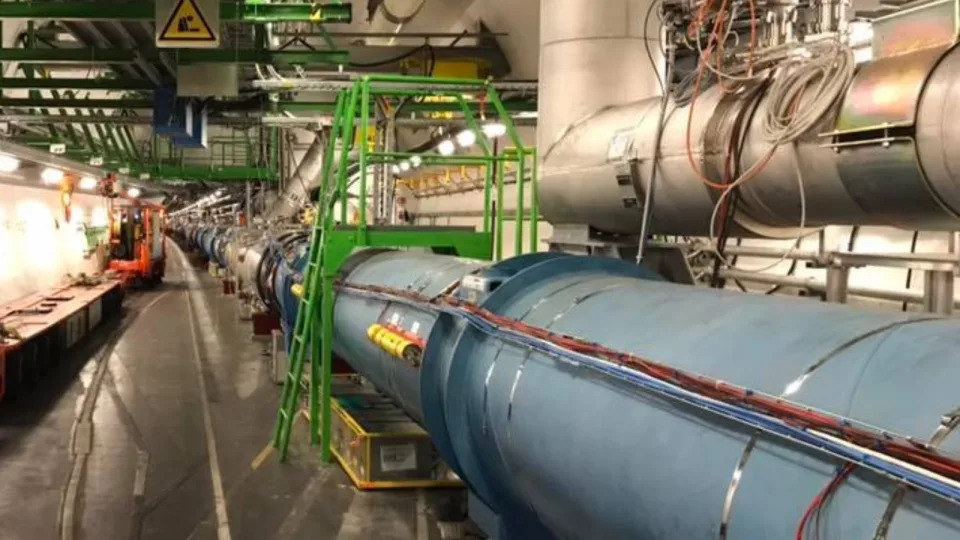
A small stretch of the near 17-mile-long LHC particle accelerator which will be dwarfed by the FCC. (Image credit: Robert Lea)
The FCC will operate in the same way as the LHC, accelerating charged particles around a loop, using superconducting magnets, then smashing them together as they approach the speed of light.
Scientists can probe fundamental physics by observing showers of secondary particles created when particles like protons slam together. But whereas the LHC can attain energies of around 13 terra electronvolts (TeV) when operating at full power, CERN says the FCC should be able to reach energies as great as 100 TeV.
"Our aim is to study the properties of matter at the smallest scale and highest energy," CERN director-general Fabiola Gianotti said at the interim report presentation in Geneva on Tuesday (Feb 6.)
Why do particle accelerators need more power?
The crowning achievement of the LHC thus far is undoubtedly the discovery of the Higgs Boson, the force-carrying particle of a field called the Higgs Field, which permeates the universe and dictates most other particles' masses.
The breakthrough sighting of the Higgs Boson by two LHC detectors was announced on July 4, 2012, and is credited with completing the Standard Model of particle physics, which is humanity's best description of the universe, its particles and their interactions on a subatomic scale.
Yet, the Standard Model still requires some tweaking — and, since 2012, scientists have been using the LHC to search for physics beyond the model to make those adjustments. Success has been limited. This search will get a boost when the LHC's high luminosity upgrade is completed, which will mean the particle accelerator can perform more collisions and offer scientists more opportunities to spot exotic physics.
Robert Lea
SPACE.COM
Thu, February 8, 2024
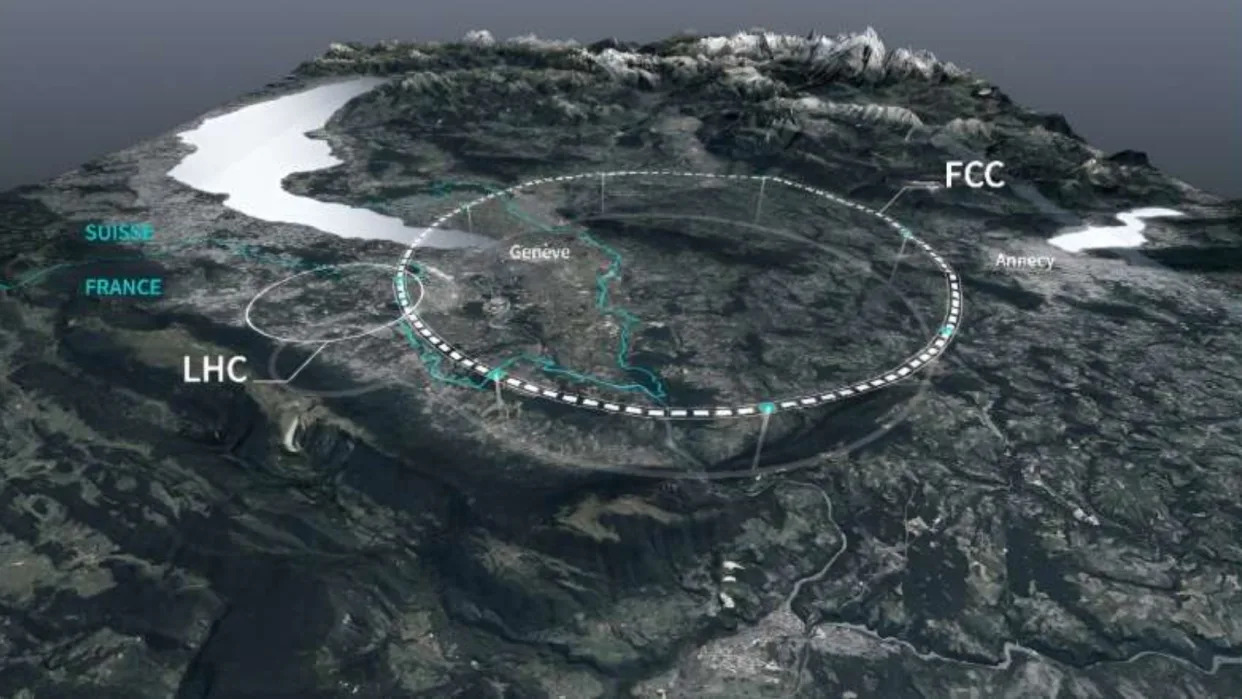
Planning is well underway for the successor to the world's most powerful particle accelerator, the Large Hadron Collider (LHC).
The new "atom smasher," named the Future Circular Collider (FCC), will dwarf the LHC in size and power. It will smash particles together with so much energy, in fact, that scientists say it may be capable of investigating our universe's most mysterious entities: Dark energy and dark matter.
LHC operators at CERN revealed the results of a "midterm review" of their FCC Feasibility Study to the press on Monday (Feb. 5). The feasibility study began in 2021 and is set to conclude in 2025. The findings thus far constitute three years of work, with scientists and engineers from across the globe determining the placement of the new accelerator's ring, the implementation of the FCC facility, concepts for detectors and funding aspects.
The FCC will run under the jurisdiction of France and Switzerland, just like the LHC currently does, but the future accelerator will stretch 56.5 miles (90.7 kilometers), making it over three times the length of CERN's current particle accelerator, which is 16.8 miles (27 kilometers) long. The LHC is the largest and most powerful particle accelerator in the world.
Related: Dark matter may be hiding in the Large Hadron Collider's particle jets
Thu, February 8, 2024

Planning is well underway for the successor to the world's most powerful particle accelerator, the Large Hadron Collider (LHC).
The new "atom smasher," named the Future Circular Collider (FCC), will dwarf the LHC in size and power. It will smash particles together with so much energy, in fact, that scientists say it may be capable of investigating our universe's most mysterious entities: Dark energy and dark matter.
LHC operators at CERN revealed the results of a "midterm review" of their FCC Feasibility Study to the press on Monday (Feb. 5). The feasibility study began in 2021 and is set to conclude in 2025. The findings thus far constitute three years of work, with scientists and engineers from across the globe determining the placement of the new accelerator's ring, the implementation of the FCC facility, concepts for detectors and funding aspects.
The FCC will run under the jurisdiction of France and Switzerland, just like the LHC currently does, but the future accelerator will stretch 56.5 miles (90.7 kilometers), making it over three times the length of CERN's current particle accelerator, which is 16.8 miles (27 kilometers) long. The LHC is the largest and most powerful particle accelerator in the world.
Related: Dark matter may be hiding in the Large Hadron Collider's particle jets

A small stretch of the near 17-mile-long LHC particle accelerator which will be dwarfed by the FCC. (Image credit: Robert Lea)
The FCC will operate in the same way as the LHC, accelerating charged particles around a loop, using superconducting magnets, then smashing them together as they approach the speed of light.
Scientists can probe fundamental physics by observing showers of secondary particles created when particles like protons slam together. But whereas the LHC can attain energies of around 13 terra electronvolts (TeV) when operating at full power, CERN says the FCC should be able to reach energies as great as 100 TeV.
"Our aim is to study the properties of matter at the smallest scale and highest energy," CERN director-general Fabiola Gianotti said at the interim report presentation in Geneva on Tuesday (Feb 6.)
Why do particle accelerators need more power?
The crowning achievement of the LHC thus far is undoubtedly the discovery of the Higgs Boson, the force-carrying particle of a field called the Higgs Field, which permeates the universe and dictates most other particles' masses.
The breakthrough sighting of the Higgs Boson by two LHC detectors was announced on July 4, 2012, and is credited with completing the Standard Model of particle physics, which is humanity's best description of the universe, its particles and their interactions on a subatomic scale.
Yet, the Standard Model still requires some tweaking — and, since 2012, scientists have been using the LHC to search for physics beyond the model to make those adjustments. Success has been limited. This search will get a boost when the LHC's high luminosity upgrade is completed, which will mean the particle accelerator can perform more collisions and offer scientists more opportunities to spot exotic physics.
THE GOD DAMN PARTICLE
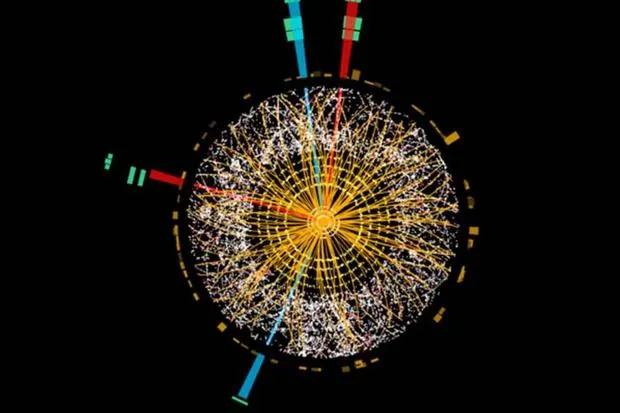
A Higgs boson decays recorded in a particle collision recorded by the ATLAS detector at the LHC on May 18, 2012. (Image credit: ATLAS)
The two main outliers of the Standard Model (aka, why some of those tweaks are necessary) are dark matter and dark energy.
Sometimes collectively known as the "dark universe," these phenomena constitute such large mysteries for scientists because dark energy accounts for around 68% of the universe's energy and matter, while dark matter accounts for around 27% of these continents. But neither can be seen because they don't interact with light, and no one has been able to pin them down through other forms of direct detection, either. That means that the matter and energy we understand and can account for comprise no more than 5% of the universe's contents, and we have little idea what around 95% of the universe actually is.
And probing these aspects of the universe may require smashing particles together with much more energy than the high-luminosity LHC is capable of.
To begin with, dark matter can't be "standard matter" like the atoms that make up the stuff we see around us on an everyday basis, like stars, planets and our bodies. Remember how it doesn't interact with light? Well, protons, neutrons and electrons — collectively known as "baryons" — do. So, dark matter must be something else.
Currently, the only way scientists can infer the presence of dark matter is via its interaction with gravity and the effect this has on baryonic matter and, in turn, light.
Dark energy is even more problematic. It's the force that scientists see driving the acceleration of the universe's expansion.
It concerns a period of expansion separate from the universe's initial inflation, which was triggered by the Big Bang. After that early expansion slowed to a near halt, in a later epoch, the universe unexplainably started to expand again. This expansion rate is actually speeding up to this day, with dark energy used to account for that action.
Yet, as we've discussed, scientists don't actually know what dark energy is.
To see why that is troubling, imagine pushing a child on a swing. The Big Bang is akin to your first and only push that gets the swing in motion. The swing may keep going for a short while, even without any action from you, then it will come to a half. Then, imagine that it suddenly begins motion again despite you just standing there. And not only that, but it swings faster and faster, reaching higher and higher points. This is similar to what dark energy is doing to the very fabric of space.
CERN hopes the high-energy collisions of the FCC could reveal the nature of this ongoing, late-universe push and the particles that make up dark matter.
However, it will be some time before this future particle accelerator is ready to embark on its investigation of the dark universe.
The timeline and cost of the Future Circular Collider
In 2028, three years after the completion of the FCC feasibility study, CERN member states will convene to decide if the FCC will get the go-ahead. Should the future collider get greenlit, CERN says, construction will begin in the mid-2030s.
The FCC will be completed in stages. The first stage is a electron-positron collider (FCC-ee) that will slam together negatively charged electrons, their positive antiparticle counterparts, known as positrons, and other light particles. CERN adds that FCC-ee should start operations in 2045.
The second machine of the FCC will be a proton colliding accelerator (FCC-hh) sitting alongside the FCC-ee in the same evacuated tunnel buried under the French-Swiss Alps and Lake Geneva. This part would come online no sooner than 2070, according to CERN.
Related Stories:
— Massive galaxy with no dark matter is a cosmic puzzle
— Researchers dig deep underground in hopes of finally observing dark matter
— Euclid 'dark universe' telescope captures 1st full-color views of the cosmos (images)
At the CERN press conference, Gianotti laid out some of the costs of the FCC, saying that the first FCC-ee stage alone would cost an estimated $17 billion USD.
CERN's Director general justified the cost by adding that the FCC is the only machine that would allow humanity to make the big jump in studying matter needed to crack the secrets of the dark universe.

A Higgs boson decays recorded in a particle collision recorded by the ATLAS detector at the LHC on May 18, 2012. (Image credit: ATLAS)
The two main outliers of the Standard Model (aka, why some of those tweaks are necessary) are dark matter and dark energy.
Sometimes collectively known as the "dark universe," these phenomena constitute such large mysteries for scientists because dark energy accounts for around 68% of the universe's energy and matter, while dark matter accounts for around 27% of these continents. But neither can be seen because they don't interact with light, and no one has been able to pin them down through other forms of direct detection, either. That means that the matter and energy we understand and can account for comprise no more than 5% of the universe's contents, and we have little idea what around 95% of the universe actually is.
And probing these aspects of the universe may require smashing particles together with much more energy than the high-luminosity LHC is capable of.
To begin with, dark matter can't be "standard matter" like the atoms that make up the stuff we see around us on an everyday basis, like stars, planets and our bodies. Remember how it doesn't interact with light? Well, protons, neutrons and electrons — collectively known as "baryons" — do. So, dark matter must be something else.
Currently, the only way scientists can infer the presence of dark matter is via its interaction with gravity and the effect this has on baryonic matter and, in turn, light.
Dark energy is even more problematic. It's the force that scientists see driving the acceleration of the universe's expansion.
It concerns a period of expansion separate from the universe's initial inflation, which was triggered by the Big Bang. After that early expansion slowed to a near halt, in a later epoch, the universe unexplainably started to expand again. This expansion rate is actually speeding up to this day, with dark energy used to account for that action.
Yet, as we've discussed, scientists don't actually know what dark energy is.
To see why that is troubling, imagine pushing a child on a swing. The Big Bang is akin to your first and only push that gets the swing in motion. The swing may keep going for a short while, even without any action from you, then it will come to a half. Then, imagine that it suddenly begins motion again despite you just standing there. And not only that, but it swings faster and faster, reaching higher and higher points. This is similar to what dark energy is doing to the very fabric of space.
CERN hopes the high-energy collisions of the FCC could reveal the nature of this ongoing, late-universe push and the particles that make up dark matter.
However, it will be some time before this future particle accelerator is ready to embark on its investigation of the dark universe.
The timeline and cost of the Future Circular Collider
In 2028, three years after the completion of the FCC feasibility study, CERN member states will convene to decide if the FCC will get the go-ahead. Should the future collider get greenlit, CERN says, construction will begin in the mid-2030s.
The FCC will be completed in stages. The first stage is a electron-positron collider (FCC-ee) that will slam together negatively charged electrons, their positive antiparticle counterparts, known as positrons, and other light particles. CERN adds that FCC-ee should start operations in 2045.
The second machine of the FCC will be a proton colliding accelerator (FCC-hh) sitting alongside the FCC-ee in the same evacuated tunnel buried under the French-Swiss Alps and Lake Geneva. This part would come online no sooner than 2070, according to CERN.
Related Stories:
— Massive galaxy with no dark matter is a cosmic puzzle
— Researchers dig deep underground in hopes of finally observing dark matter
— Euclid 'dark universe' telescope captures 1st full-color views of the cosmos (images)
At the CERN press conference, Gianotti laid out some of the costs of the FCC, saying that the first FCC-ee stage alone would cost an estimated $17 billion USD.
CERN's Director general justified the cost by adding that the FCC is the only machine that would allow humanity to make the big jump in studying matter needed to crack the secrets of the dark universe.
A four-legged ‘Robodog’ is patrolling the Large Hadron Collider
Mack DeGeurin
Thu, February 8, 2024
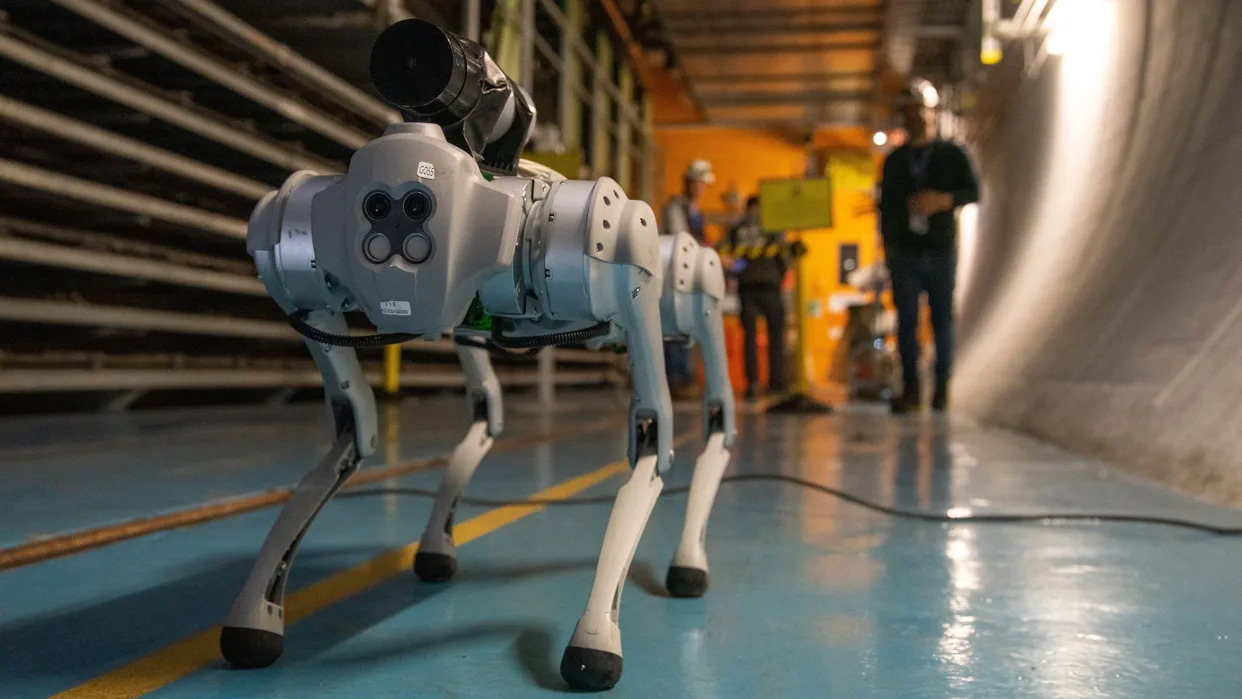
CERT’s four-legged Robodog can maneuver through cramped spaces and use sensors to spot fires, leaks, or other hazards.
Traversing through the dark, underground areas of the Large Hadron Collider (LHC) in Geneva, Switzerland isn't for the faint of heart. The world’s most powerful particle accelerator violently smashes protons and other subatomic particles together at nearly the speed of light, which can emit radiation at levels potentially harmful to humans. If that weren't enough, long stretches of compact, cluttered areas and uneven surface areas throughout the facility make stable footing a necessity.
Scientists at the European Organization for Nuclear Research (CERN) are turning to four-legged, dog-inspired robots to solve that problem. This week, CERN showed off its recently developed CERNquadbot robot which they said successfully completed its first radiation survey in CERN’s North Area, the facility's largest experimental area. Looking forward, CERN plans to have its “Robodog” trot through other experiment caves to analyze areas and look for hazards.
Why does CERT need a robot dog?
The hazardous, sometimes cramped confines of the LHC’s experiments caverns pose challenges to both human workers and past robot designs alike. Temporary radiation levels and other environmental hazards like fires and potential water leaks can make some areas temporarily inaccessible to humans. Other past CERT robots, while adept at using strong robotics arms to carry heavy objects over distance, struggle to traverse over uneven ground. Stairs, similarly, are a nonstarter for these mostly wheeled and tracked robots.
That’s where CERT’s robot dog comes in. CERTquadbot’s four, dog-like legs allow it to traverse up and down and side to side, all while adjusting for slight changes on the ground's surface. A video of the robot at work shows it tic-tacking its four metal legs up and down as it navigates through what looks like pavement and a metal grated floor, all the while using onboard sensors to analyze its surroundings. A human operator can be seen nearby directing the robot using a controller. For a touch of added flair, the robot can also briefly stand up on its two hind legs. The Robodog had to use all of its various maneuverability during its recent test-run up the North area, which was reportedly filled with obstacles.
“There are large bundles of loose wires and pipes on the ground that slip and move, making them unpassable for wheeled robots and difficult even for humans,” CERN’s Controls, Electronics and Mechatronics robotics engineer Chris McGreavy said in a statement.
Thankfully for the CERN scientists, the Robodog rose to the occasion. And unlike other living dogs, this one didn’t need a tasty treat for a reward.
“There were no issues at all: the robot was completely stable throughout the inspection,” McGreavy added.
https://youtu.be/cbcpJZicJ2w?si=35A_xHeZ7si6lhtX
Now with the successful test completed, CERN says it's upgrading the robot and preparing it and its successors to deploy in experiment caves, including the ALICE detector which is used to study quark-gluon plasma. These areas often feature stairs and other complex surfaces that would stump CERN’s other, less maneuverable robots. Once inside, the robot dogs will monitor the area for hazards like fire and water leaks or quickly respond to alarms.
CERN directed PopSci to this blog post when we asked for more details regarding the robot.
Dog-inspired dogs are going where humans can’t
Four-legged quadruped robots have risen in popularity across numerous industries in recent years for their ability to nimbly access areas either too cumbersome or dangerous for humans and larger robots to access. Boston Dynamics’ “Spot,” possibly the most famous quadruped robot currently on the market, has been used to inspect dangerous offshore oil drilling sites, explore old abandoned mining facilities, and even monitor a major sports arena in Atlanta, Georgia. More controversially, law enforcement officials in New York City City and at the southern US border have also turned to these quadruped style robots to explore areas otherwise deemed too hazardous for humans.
Still, CERN doesn’t expect its new Robodog to completely eliminate the need for the other models in its family of robots. Instead, the various robots will work together in tandem, using their respective strengths to fill in gaps with the ultimate goal of hopefully speeding up the process of scientific discovery.
No comments:
Post a Comment